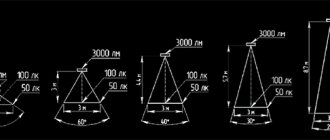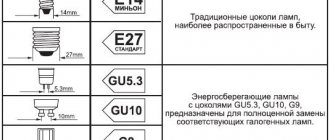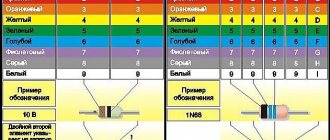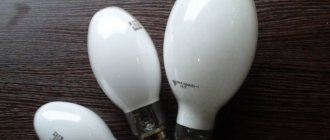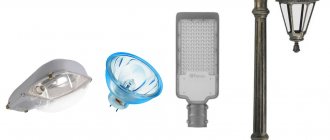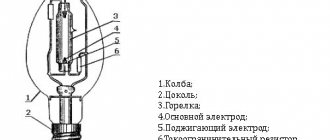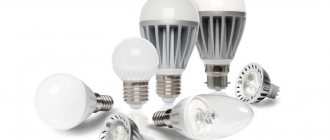The vast majority of people when buying an LED lamp pay attention to two parameters - price and brightness (luminous flux). In fact, there are a dozen more selection criteria that should be paid attention to.
Main selection criteria : manufacturer, luminous flux (brightness), power, supply voltage, color temperature, base type, dispersion angle, dimensions.
Additional criteria : dimming capability, operating temperature range, light flux pulsation.
Let's look at each item of technical specifications in detail.
Light flow
For most LED lamps, the luminous flux is 80-100 lm/W. There are LEDs based on COB technology, whose luminous flux reaches 180 lm/W, but they are not used in household products. In Chinese light bulbs, the normal brightness is 70-80 lm/W.
Comparative table of light output of different types of lamps
Detailed analysis: What is the luminous flux of diode lamps.
Adjustable LED lamps
LED devices allow you to adjust the brightness of the lighting. This happens with the help of a control device - a dimmer. The regulator helps to obtain the most suitable light that will not strain your eyesight. The dimmer works by generating pulses. Their frequency affects the brightness of the lighting. Not all LED systems can be adjusted using a dimmer. Its functions can be performed by a driver that is built into the lamps. In this case, the functionality will be somewhat limited.
If the buyer needs dimmable equipment, it is worth carefully studying the packaging of the products. All manufacturers write on the boxes about the possibility of adjusting lighting.
Power
The power of an LED lamp is a derivative of the luminous flux, or vice versa. Please note that the LED parameters indicate the total power of the lamp and driver.
| Table of power and luminous flux ratio | |
| LED power, W | Luminous flux, Lm |
| 3-4 | 250-300 |
| 4-6 | 300-450 |
| 6-8 | 450-600 |
| 8-10 | 600-900 |
| 10-12 | 900-1100 |
| 12-14 | 1100-1250 |
| 14-16 | 1250-1400 |
Colorful temperature
Color temperature is a very important criterion when choosing LEDs.
Warm white light (2700-3200K). Warm light has a spectrum similar to that of an ordinary incandescent light bulb.
Neutral white light (3200-4500K). Bulbs with neutral white light are as close to daylight sunlight as possible. An ideal solution for illuminating the work area.
Cool white light (more than 4500K). These LED lamps have a white-blue glow. The best option for work spaces where increased concentration is required.
Detailed analysis: glow temperature of LED lamps.
Characteristics of LED lamps
To choose the right LED light bulb, you need to study all its parameters. The light it emits differs from the more familiar emission of incandescent lamps. Moreover, this luminous flux is far from being as uniform as before.
LEDs differ greatly in color rendering shade (color temperature), scattering angle and other parameters of the emitted glow.
When buying an LED lamp, the main attention should be paid not to large advertising figures, but to the description of the parameters in small print - all the most interesting things are there. Studying them in detail will help you avoid many mistakes.
The abbreviation "LED" stands for Light-Emitting Diode. These are LED artificial lighting lamps, which are sold in lighting stores. They are used in lighting devices installed both outdoors and in rooms of various purposes.
There is no uniform mandatory labeling for all LED lamps. Each manufacturer creates its own article number. Of course, it contains the main technical characteristics of the product.
However, this is often done in the form of abbreviations, which are not so easy to understand. In this case, a number of parameters are indicated only on the light bulb box.
All this must be taken into account when choosing LED. It is recommended to select LED lamps individually for each room and lighting area. In this matter, not only the color temperature is important, but also other characteristics of the LED lamp, and it has many of these parameters.
Color temperature and luminescence shade
On the packaging of each LED lamp, the color temperature indicator is always in the most visible place. This is the main characteristic of this lighting device.
If for conventional light bulbs with a tungsten filament the color of light is in a narrow range of 2200–2800 K, then for LED bulbs it fluctuates over a much wider range.
Often the “color temperature” of an LED lamp is mistakenly equated with the “heat” it emits, but LED, unlike the “Ilyich bulb,” practically does not emit thermal energy when illuminated (+)
This indicator does not correlate in any way with the heating temperature of the surface of the LED light bulb and the heat emitted by it. At maximum, the LED can heat up to 60–65°C. For comparison, an analogue with a 100 W filament heats up to 250–265°C.
Almost all the electrical energy in an LED is converted into light. And no matter what color spectrum it belongs to, the surface heating temperature will always be approximately the same.
All LED lamps according to color temperature (color of light) are usually divided into three groups:
- WW (Warm White) – “warm white” with an emission spectrum of 2700–3300 K;
- NW (Neutral White) – “natural white” with a range of 3300–5000 K;
- CW (Cool White) – “cold white” with light emission >5000 K.
According to human perception, the first option approximately corresponds to the illumination on the street from the sun at the horizon. The second is sunlight at lunchtime in clear weather. The third at the beginning of the range coincides with the sun shining at its zenith, and when it goes to 6500–7500 K it is equal to natural light during the day when it is cloudy.
The color temperature of the LED indicates the shade of light emitted by the lamp in the lighting fixture - warm “WW” tones calm, and cold “CW” tones, on the contrary, invigorate and set the mood for work (+)
When choosing the color of light, you need to focus on where the lamps will subsequently be used. Warm yellow shades are more suitable for bedrooms, and whites of a natural or cool spectrum are more suitable for a corridor or kitchen.
Selecting LEDs wisely is a science. And the main thing here is to start from the most illuminated room. An incorrectly selected LED light bulb can greatly harm a person’s vision.
Lighting designers have to take into account not only the color of the LED, but also the brightness and color rendering of the light source. In this case, the influence of the created lighting on people’s perception also plays an important role.
The human eye, when entering a room from the street, has to quickly adapt to the changed illumination. Often the colors of objects even seem distorted and incorrect in the first minutes.
Color rendering degree of LED lamps
The second most important indicator of the light of an LED lamp is the color rendering index, designated CRI or Ra. This indicator is responsible for the natural transmission of all shades of color from an object that falls into the beam of a lighting device.
The maximum Ra is 100 (this is the reference sunlight that a person encounters at noon in clear weather) - usually this parameter for LED lamps ranges from 80–90 (+)
If Ra<80, then objects in an LED-lit room will visually appear dim. It should be understood that the perception of colors is individual for each person. Plus, with age, it also becomes distorted.
It is customary to take the undistorted color rendition, which is formed when an object is illuminated by the rays of the sun, as the standard Ra=100. That is, this is how we usually see it on the street in bright natural rather than artificial indoor lighting.
The color rendering index of LED lamps can be divided into four classes:
- 100 – maximum, which is equivalent to the perception of color in natural light;
- from 100 to 90 - such light bulbs are designed for places where the most accurate color reproduction is required (laboratories, work desks and areas);
- from 90 to 80 – options for ordinary living rooms and general lighting;
- below 80 – lamps in luminaires for corridors, toilets and utility rooms, where high quality shade transfer is not so important.
There is no direct connection between color rendering and color temperature. These are independent characteristics of an LED lamp.
Scattering angle and glow intensity
One of the advantages of LED lamps over conventional lamps is the narrow directionality of the lighting flow. By itself, one LED produces a light beam only directly in the direction from its body.
An LED light bulb usually contains several or a whole array of them to create a specific cone of light. The same incandescent light bulb, on the contrary, shines in all directions at once, all around.
Lamps with a narrow scattering angle are widely used in zoning rooms and in night lamps; with their help, designers place light accents and highlight a separate space in the interior
The luminous flux of LED bulbs can be scattered at an angle from 60 to 340°. Narrowly directed options are used to organize oriented spot lighting and to illuminate specific areas in the interior. Wide angle lamps are designed for general ceiling lighting.
Glow intensity (luminous output) reflects the emission efficiency of the LED lamp. This characteristic is measured in lm/W. The value in lumens (lm) is the value of the luminous flux, and Watts is the power of the light bulb. In the marking they are indicated together as a single figure in lm/W or separately.
The higher this indicator, the more energy efficient and economical the LED lamp is. On the other hand, the higher the luminous flux of a particular light bulb, the fewer such products will be needed to illuminate the room.
Base type
The most common type of base is E27. On the Internet, most of the technical specifications are for these LED lamps. This is the classic size of the base for ordinary incandescent light bulbs.
| Scheme | Designation | Purpose |
| E14 Minion | Traditional bases, the most popular in everyday life | |
| E27 Standard | ||
| E40 | Designed for high-power light bulbs. Lighting of large rooms or streets | |
| G4 | These sockets are used to completely replace halogen lamps with LEDs | |
| GU5.3 | ||
| GU10 | ||
| GX53 | Used in lamps (built-in or overhead) in furniture or ceilings | |
| G13 | Tubular swivel base used in T8 lamps |
Home light bulbs with E27 socket
An LED light source with an E27 threaded base is ideal for home use. This is due to its interchangeability with traditional incandescent lamps. It is enough to unscrew one lamp from the socket and replace it with another. If we talk about the technical characteristics of the E27 LED lamp, then all the parameters are identical to those discussed above.
Whatever the types of LED lamps, they all have the characteristics discussed above. This must be taken into account when choosing a product in order to select a suitable light source.
Scattering angle
Manufacturers produce lamps of various shapes and sizes for the E27 base. Depending on the design and design features, the dispersion angle can be from 300 to 3200. Depending on the dispersion angle, the illuminated area also differs. This can be clearly understood from the figure below.
For general lighting, for example, a chandelier in the living room, a model with a maximum scattering angle is required, for a table lamp, on the contrary, with a minimum.
You can understand the approximate angle of dispersion of the light flux by looking at the form factor of the diode light bulb.
Operating temperature range
By default, the normal operating temperature of LEDs is from -30C0 to +60C0. In some regions, outdoor temperatures during winter may fall below these limits.
It is also not recommended to install such lamps in rooms with high temperatures, for example, a sauna steam room, or near powerful heat sources.
Working in extreme temperatures
For LEDs, the upper limit of ambient temperature corresponds to a 30% drop in luminous flux.
The operation of LED lamps at low temperatures significantly reduces the heating of the semiconductor crystal, which increases its uninterrupted operation time.
Extra options
Product service life
Service life is a very abstract characteristic of an LED lamp. The fact is that by service life the manufacturer understands the total operating time of the LEDs, not the lamp. At the same time, the mean time between failures of the remaining parts of the circuit remains in great doubt. In addition, the operating time is affected by the quality of the housing assembly and soldering of radio elements. In addition, more than one manufacturer, due to its long service life, does not conduct full tests on the degradation of LEDs in the lamp. So the declared 30 thousand hours or more is a theoretical indicator, and not a real parameter.
Flask type
Despite the fact that the type of flask is not a critical technical parameter for many, in many models it is indicated in the first line. Typically, the type and marking of the flask is expressed in a alphanumeric code.
Flask type
Weight
Rarely is anyone interested in the weight of a product at the time of purchase, but for some lightweight lamps it matters.
Dimensions
There are as many cases as there are manufacturers, differing in appearance and dimensions. For example, 10 W LED lamps from different manufacturers may differ in length and width by more than 1 cm. When choosing a new LED lamp for lighting, do not forget that it must fit into an existing lamp.
The market for LED products continues to develop dynamically, as a result of which the characteristics of lamps change and improve. We hope that in the near future quality standards will be developed for LED lamps that will make it easier for the buyer to make a choice.
Actual parameters of LED lamps
The table below shows the results of testing twenty-six LED light bulbs from various manufacturers. For famous brands Osram and Philips, passport data always corresponds to real parameters. For others, the luminous flux of the product may be a quarter lower than the declared parameters.
Table of correspondence between denominations of different manufacturers
Pay attention to the bottom position. Bellight LEDs produced in Poland have significant discrepancies in their design parameters. Such diodes are definitely not worth buying. Not only will you pay twice as much for “virtual” lumens, but with such a pulsation coefficient, installing them in residential areas is hazardous to health.
For clarity, we present data from testing Chinese light bulbs.
Design and principle of operation
Externally, a 220V LED lamp consists of elements familiar to the eye: a base that follows the shape of standard connectors for incandescent lamps and a glass dome.
Inside there is a completely new design, which includes: reinforced housing - radiator; drivers are unique control panels; boards with built-in one or more LEDs; a diffuser of light rays with a phosphor substance applied to it. The phosphor slightly dulls the artificial light of the diode and at the same time saturates it with other “sunny” shades.
The diode is based on semiconductor materials (germanium, silicon), and is very similar to the operation of a semiconductor device. When charge carriers of electrons and holes pass in the forward direction, photons are released - elementary particles of electromagnetic radiation in the light range. This effect makes the LED light up.
Since new types of lamps are widely used in all areas of life, formally, according to the type of design, they can be divided into categories:
- General purpose - for residential premises and offices (round, oblong or candle-shaped);
- With a directional luminous flux - for illuminating landscapes and architectural monuments using a spotlight;
- Linear, designed to replace fluorescent ones (tube shape).
conclusions
For all its attractiveness, buying an LED lamp has many pitfalls.
Purchasing products from world-famous brands eliminates the occurrence of “surprises” during operation. Only such a lamp will cost 2-3 times more expensive. The most famous LED manufacturers are Philips, Osram, Bosh, Ikea.
The middle price range, when price reductions do not affect quality, includes the following manufacturers: Jazzway, Feron, Navigator, Unitel, Lexman, Wolta. Among their assortment, there are not entirely successful models, but mostly they encounter small discrepancies between the real and the rated light flux.
Super budget LED . From time to time, very inexpensive LED lamps mainly of Chinese origin appear on the market. These products are guaranteed to have an increased luminous flux and contain the simplest current stabilizers. The lifespan of such paws is not much longer than energy-saving ones.
Please rate the article. We tried our best:)
Did you like the article? Tell us about her! You will help us a lot :)

